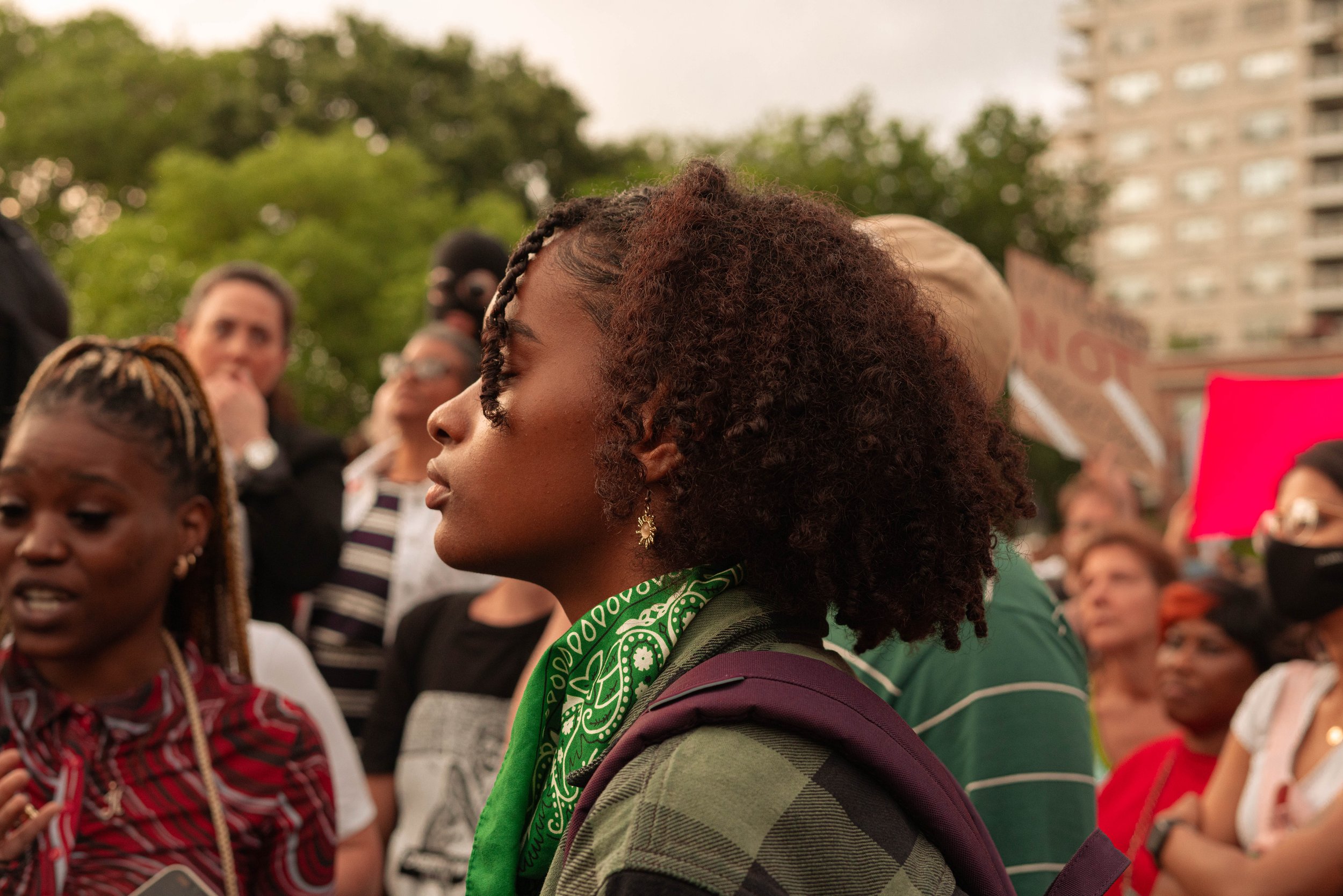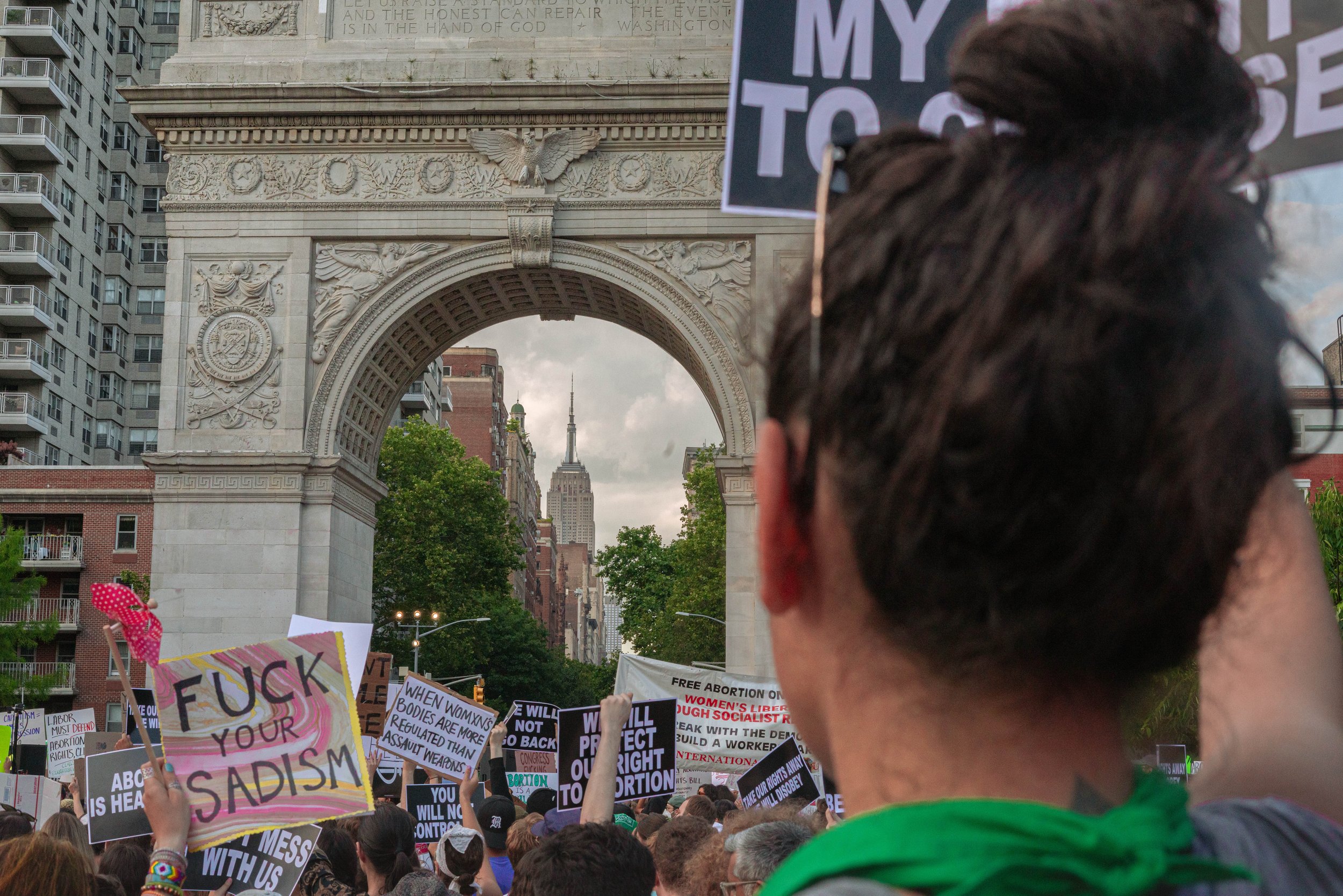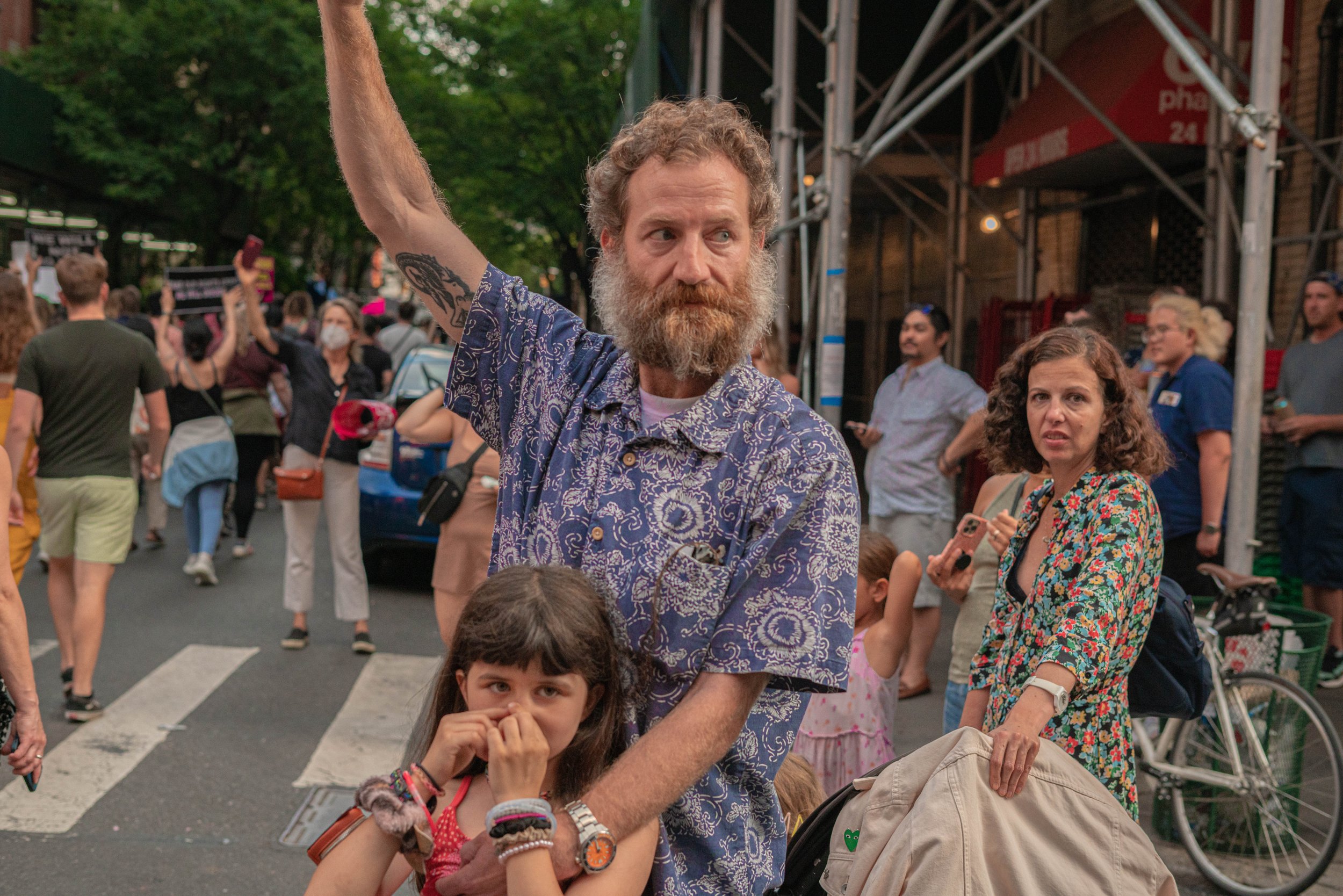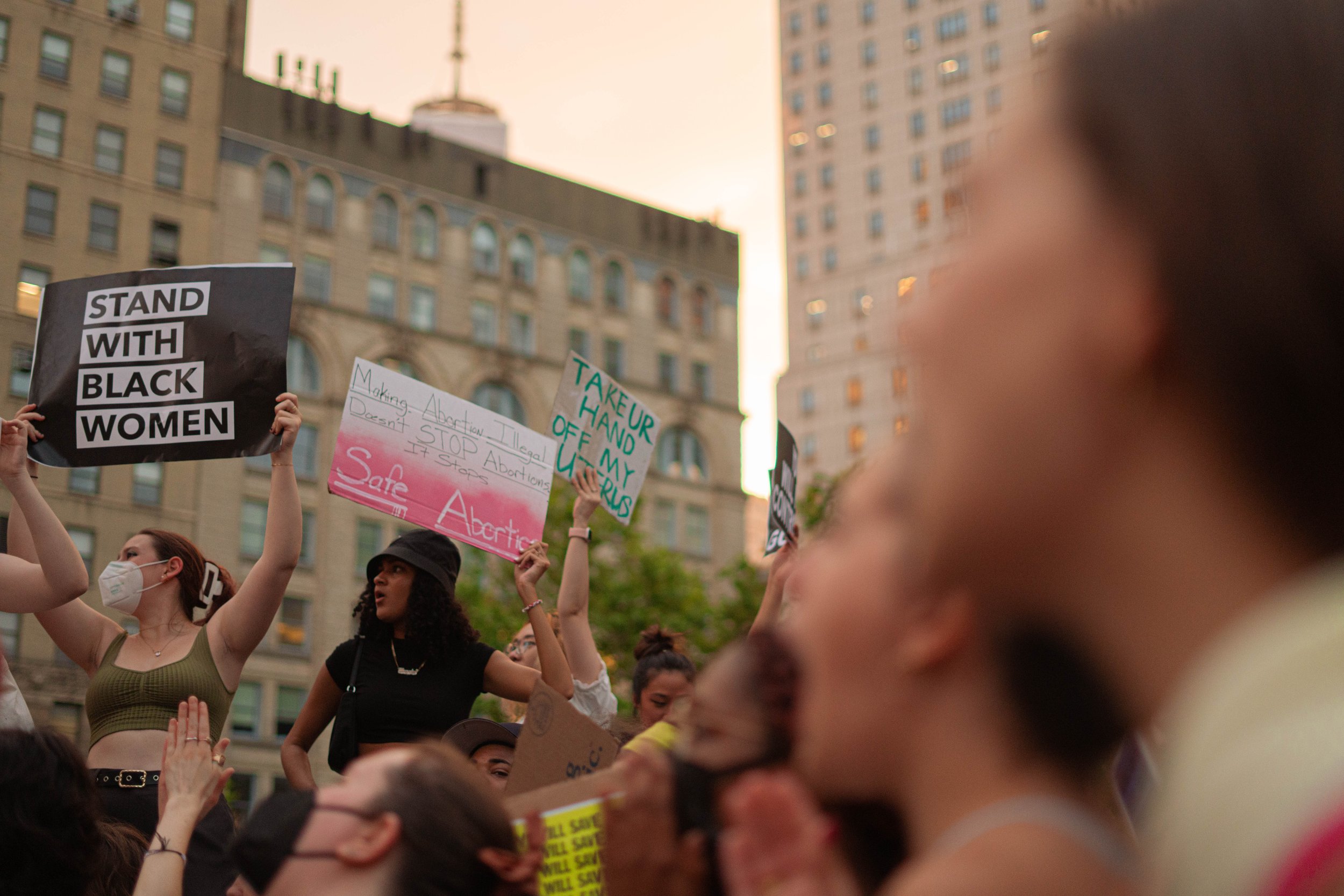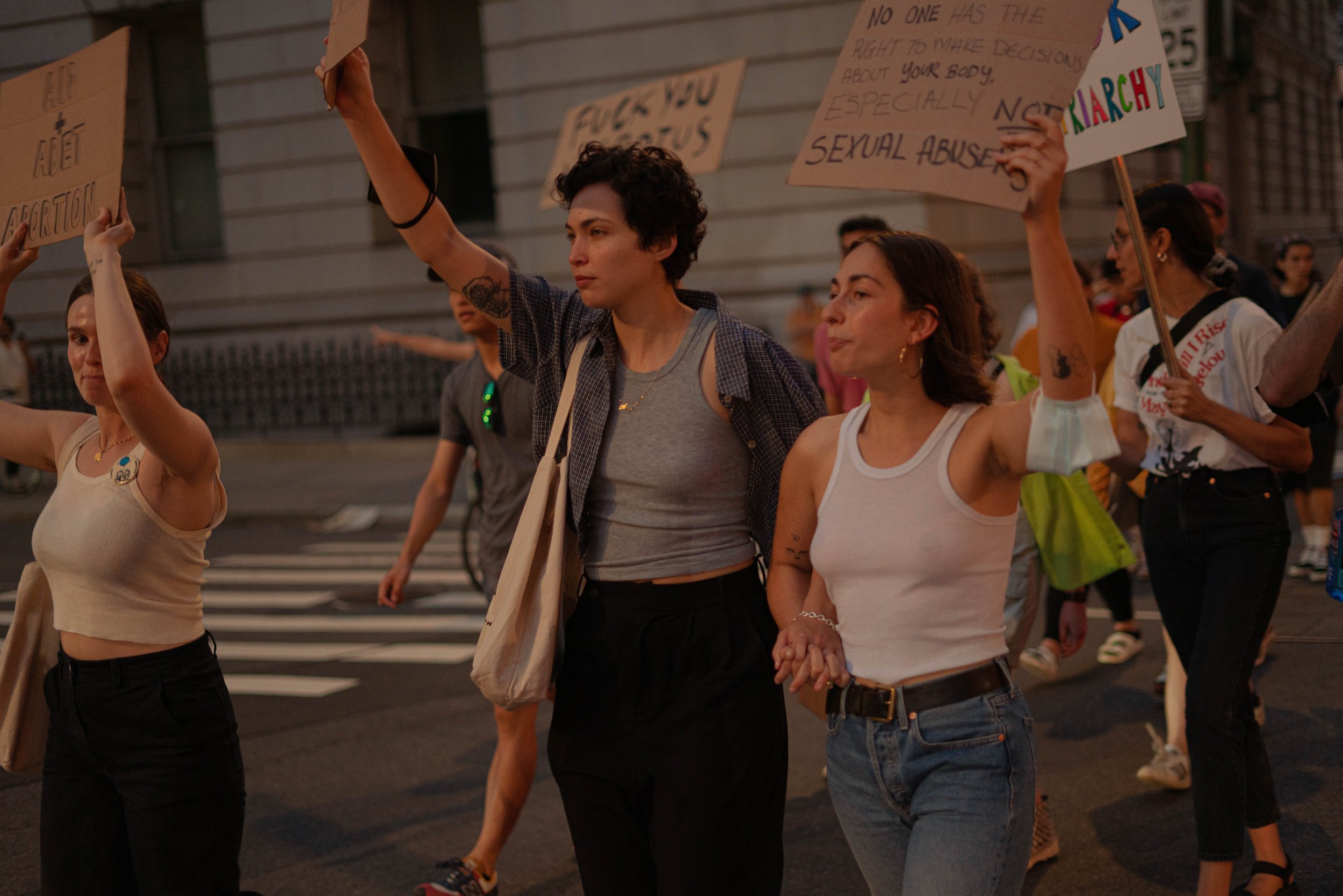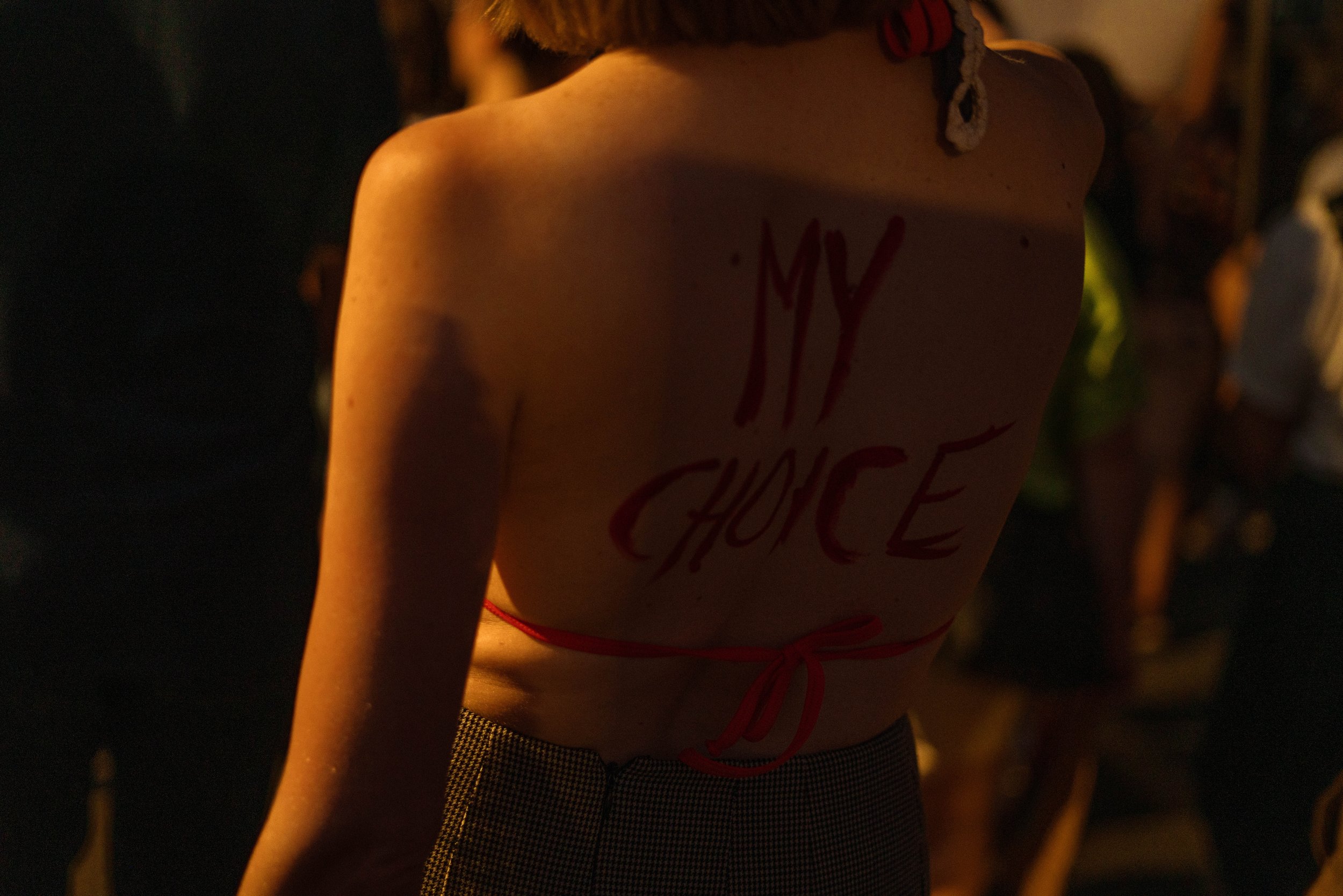Fountains of Blood
| Photo by Bethany Johnson
It was like trying to move through Times Square on New Year’s Eve.
“Excuse me, sorry. Excuse me, sorry. Excuse me, sorry,” I repeated like a broken record to each person I shoved past.
It was 6:40 p.m. I followed behind my friend, Bethany, as we pushed through the claustrophobia-inducing crowd in the 75-degree heat of that June evening. The two other girls we arrived with were already separated from us in the commotion.
The sound of chanting and shouting grew louder as we neared the center of Washington Square Park.
“No justice? No peace! No justice? No peace! No justice? No peace!”
Many protestors wore green. Others held wire hangers. Some women wore tanks or bikini tops with “MY BODY MY CHOICE” painted across their chests and blood-red paint smeared down their legs.
Most had just taken a piece of cardboard and created a sign right on the sidewalk with a Sharpie — signs that read, “ABORTION RIGHTS ARE HUMAN RIGHTS” and “ABORT THE COURT,” along with more crude ones that read, “F*CK THE PATRIARCHY” and “F*CK CLARENCE THOMAS.”
Roe v. Wade, the Supreme Court case that legalized abortion for nearly 50 years, was overturned that morning on June 24, 2022.
The 1973 case, decided in a 7-2 ruling, upheld the constitutional right to an abortion before the point of fetal viability and established the framework for abortion regulation. It was affirmed by Planned Parenthood v. Casey in 1992.
We finally made it to the middle of the park. Here, we could barely move side-to-side, let alone get closer to the speakers.
We hopped the wall of the fountain and walked around the inner edge of the pool, ducking underneath the arches of shooting water and shielding Bethany’s Sony a7R Mark II camera and Røde mic from the spray.
We stopped behind three young women standing on a pillar of the fountain wall. They grasped onto each other so as not to fall even though they were strangers to each other.
Ky, 23, was one of them. She had long blonde braids that reached the base of her back and wore a Y2K swirl-patterned top with blue bell-bottom jeans.
“We do not need to recreate the wheel! There are amazing, beautiful Black, Brown, trans, people of color who have been doing this for f*cking decades!” Ky yelled into a black megaphone while raising a sign in her other hand. “Support them! Support them! I know how you can support them. Give them your coin if you have it and make a movement with the people. It has always been we the people! We hold the power, and it’s time for us to remember that!”
Ky, 23, at Washington Square Park on Friday, June 24. | Photo by Bethany Johnson.
The crowd roared as she stepped down and took a pull from a joint.
Ky was at work when she first heard the news. “I sobbed in the stall in the bathroom for at least 15 minutes, at least. It was gut-wrenching.”
But she wasn’t teary-eyed now. I could feel the anger and rage in her amplified voice. I could feel the palpable energy of the crowd cutting through the suffocating humidity of thousands of people packed together on a Friday.
Isabella “Isa” Fallahi, a 19-year-old Colombian-Iranian and first-generation American, took over the megaphone. Her bright lilac-pink hair stood out from the crowd. She wore an army green tank, light blue jeans with a string of beads as a belt and a cap with a red star on the front.
Though I didn’t know it at the time, it wasn’t surprising to learn that she’s been featured in the Washington Post, Elle, USA Today, MSNBC, VICE, The Guardian, Teen Vogue, Vogue Australia and Forbes for her work as an activist.
“I really felt safe, first and foremost, empowered, and above all, I was so inspired and reinstilled with hope,” Fallahi said to me. “All the issues we talked about … it’s all connected. Reproductive rights are inherently connected with Indigenous rights, Black liberation and Latino liberation and colonization, you name it.”
Fallahi was still in bed when the news broke. She woke up paralyzed from an unexplainable anxiety.
“This was even before I knew the news. I felt like I had something pressing down on my chest,” she said. “There was something in my gut — in my uterus — that just kind of f*cking knew.”
A number of people took turns with the megaphone, each more enraged than the next. Around 7:15, Fallahi yelled to the crowd that we were moving the protest to the Court House in Foley Square.
A sea of people slowly filtered out of the park and began what would be a 1.3-mile trek through Lower Manhattan, effectively shutting down the streets along the way.
Outdoor restaurant-goers cheered and whooped over their plated meals and glasses of wine. Sidewalk pedestrians stopped to clap and film the impromptu march on their phones. Drivers honked their cars with smirks on their faces.
The protestors chanted and hollered the entire way.
“Show me what democracy looks like! This is what democracy looks like! Show me what democracy looks like! This is what democracy looks like!”
“Hey hey! Ho ho! Brett Kavanaugh has got to go! Hey hey! Ho ho! Brett Kavanaugh has got to go!”
“Abortion is a human right! Not just for the rich and white! Abortion is a human right! Not just for the rich and white!”
We arrived at Foley Square. Protestors immediately climbed the inactive fountain and raised their signs to the sky. Fallahi jogged through the crowd until she stood on top of the pedestal that held a colossal black granite statue titled “Triumph of the Human Spirit.”
Adjacent to her was the New York County Supreme Court. Carved into the top of the Parthenon-style facade were the words, “THE TRUE ADMINISTRATION OF JUSTICE IS THE FIRMEST PILLAR OF GOOD GOVERNMENT.”
Fallahi urged queer women and women of color to come forward and take the megaphone.
One woman who was a victim of rape shared her experience following the assault.
“When I went to the hospital after, I had to tell every single nurse that there was no condom … I had to hope and pray every single week after that I wasn’t going to miss a period.”
A roar of boos and jeers emitted from the square.
“These laws are affecting the victims of rape … forcing these people to have babies of their abusers, OK? We cannot let that happen, OK? Wherever you’re from, in any f*cking space, you have to say something because of women like me and so many other people who are praying and hoping that there’s not a second line on that f*cking stick!”
Isabella “Isa” Fallahi, 19, leading the crowd at Foley Square. | Photo by Bethany Johnson
Protestors at Foley Square. | Photo by Bethany Johnson
The crowd’s excitement began to wane after about 30 minutes and people discussed their plans to leave when Fallahi suddenly announced our next stop: the Brooklyn Bridge.
We were on the move again at 8:30. We crossed onto the road as we approached the bridge, completely stopping the traffic driving from Manhattan into Brooklyn. The crowd continued to cheer while pedestrians on the walkway above us peered over the fence, some with their fists raised in solidarity.
The group stopped several times to chant before moving on. It started sprinkling at 8:50 and then began raining harder at 9:00, but I was grateful for the cool sensation.
As we neared the end of the bridge, someone yelled, “Bicyclists to the back!”
Those walking with bicycles dropped to the back of the crowd.
We heard another shout, “White, cis men to the front!”
We realized what was happening: the NYPD was waiting for us at the end.
“White men to the front! White men to the front! White men to the front!”
I watched as men pushed their way forward. I’d later see a picture of Fallahi leading the march with a wall of white men following behind her, arm-in-arm, and the blue-purple-yellow-red sunset of the New York skyline behind them.
We exited the bridge. There was a call for everyone to be quiet and put their hands in the air. An eerie hush settled over the crowd.
Another voice called out, “Close the gap!”
We jogged forward. I learned that was so the police couldn’t separate the group, if it came to that.
“Are we about to be arrested?” I whispered to Bethany, only half-joking.
But we had no issues. We walked right past the cops.
We ended in Brooklyn Heights near Cadman Plaza on Adams Street.
Fallahi took to the megaphone again, thanked the crowd for coming and reminded everyone to be careful on their way home.
I caught the subway at 10 p.m. from the Court Street station. Sitting in a nearly empty train car — one of the old tin-can-looking ones with orange and yellow seats and flickering lights — I listened to the dozens of recordings and videos I took.
“[I feel] more alive than I have in weeks and months,” Ky had said to me back in the park. Our heads were huddled together to hear each other over the volume of the crowd. “I feel so amazing. I feel like I am elevated right now. I feel a part of something. I feel I am at home. I feel like being here in America feels like home for once.”



